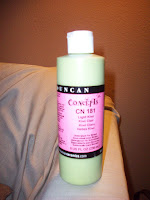

Technique: Wood fired, stoneware I think with some wheel-thrown and some handbuilt pieces. The bowl looks like it might be slab built.
Critique: I aspire to make pottery like this. At least that was what I thought when I first saw these pieces. The artist has a background in piggybank making which might be the reason these pieces have such wonderful feet. The feet are really interesting in the way they corkscrew/spiral from the base. It is a shame that our kiln had so many problems and that I did not find these pieces until finals week; I would have liked to experiment with making feet like this for a slab piece.
The second thing I like is the decoration on the bowl. The design is abstract but distinctly evokes ferns/leaves. I think what I have gotten out of this class is that sometimes it is not as important to accurately portray something like a leaf or a wave or whatever in the design of a functional peice, but to attempt to make something that is beautiful on its own. I haven't really seen my own pieces come out yet but I am already much more satisfied with the ones that have a more abstract or loose representation of leaves that those that were painstakingly made to look like a real leaf. There is one exception to this in the model assignment, which I am very proud of my pear, however that is all it is, a representation of a pear not a pear design on a bowl.
Truth be told, I like all my pieces and have really enjoyed making them. Maybe I will have an opportunity to do it again:)
The second thing I like is the decoration on the bowl. The design is abstract but distinctly evokes ferns/leaves. I think what I have gotten out of this class is that sometimes it is not as important to accurately portray something like a leaf or a wave or whatever in the design of a functional peice, but to attempt to make something that is beautiful on its own. I haven't really seen my own pieces come out yet but I am already much more satisfied with the ones that have a more abstract or loose representation of leaves that those that were painstakingly made to look like a real leaf. There is one exception to this in the model assignment, which I am very proud of my pear, however that is all it is, a representation of a pear not a pear design on a bowl.
Truth be told, I like all my pieces and have really enjoyed making them. Maybe I will have an opportunity to do it again:)












